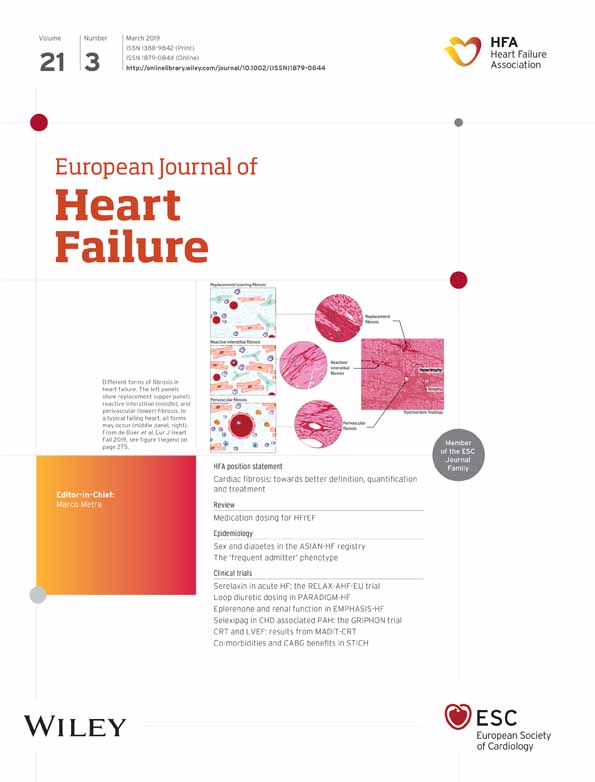March 2019 at a glance: epidemiology and clinical trials
Heart Failure News
This issue sees the start of a new section, Heart Failure News. This new section aims at having articles about new findings as well as people and institutions who have a major role in the knowledge and treatment of heart failure (HF). It will show the ‘human aspect’ of HF care and research. Andrew Coats, President-Elect of the Heart Failure Association (HFA), has the role to take care of these articles.
Pathophysiology
Fibrosis
Fibrosis has a major role in the development and progression of myocardial dysfunction.1 A position statement of the HFA reviews its causes, subtypes and characteristics, its detection through imaging modalities or plasma biomarkers, and possible therapies. A roadmap for future research is proposed.2
Epidemiology
Diabetes and sex in Asia
Asian patients have different characteristics compared with Western ones.3 Chandramouli et al.4 examined the interaction of sex and diabetes in 5255 patients enrolled in the Asian Sudden Cardiac Death in HF (ASIAN-HF) registry. Compared with diabetic men, diabetic women had a lower body mass index and were more likely to have chronic kidney disease and had more concentric left ventricular (LV) geometry. At multivariable analysis, diabetes was associated with worse outcomes in women.
The ‘frequent admitter’ phenotype
Go et al.5 applied machine learning techniques to 10 363 consecutive patients with acute HF enrolled in the Singapore Cardiac Data Bank HF registry. A high frequency of readmission cluster was identified with 2.35 ± 3.68 admissions/year. Compared to ‘non-frequent admitters’, these patients were younger, more often males, smokers and with a lower LV ejection fraction (EF). They had longer length of stay, higher annual inpatient costs (7015 vs. 2967 €) and higher mortality at 3 years [adjusted odds ratio 2.33, 95% confidence interval (CI) 2.11–2.58].
Randomized clinical trials
Serelaxin in acute heart failure: the RELAX-AHF-EU trial
The RELAX-AHF-EU study assessed the effect of serelaxin on worsening HF (WHF) and all-cause death through day 5 in 2666 patients hospitalized for acute HF in Europe using a prospective, randomized, open-label, blinded-endpoint validation study design. The trial was stopped prematurely due to the neutral results of RELAX-AHF-2.6 Adjudicated WHF/all-cause death through day 5 was reduced in the serelaxin vs. the standard of care group [5.0% vs. 6.9%; hazard ratio (HR) 0.71, 95% CI 0.51–0.98]. In contrast, the difference between treatment groups was not significant for WHF/all-cause death/HF rehospitalization through day 14 and length of hospital stay. A beneficial effect on short-term clinical course was shown also for other endpoints.7
Diuretic dose in PARADIGM-HF
Vardeny et al.8 analysed diuretic doses in the 8399 patients with HF and reduced EF (HFrEF) enrolled in the Prospective comparison of angiotensin receptor neprilysin inhibitor (ARNI) with angiotensin receptor inhibitor (ACEI) to Determine Impact on Global Mortality and morbidity in HF (PARADIGM-HF) trial. At baseline, 80.8% of participants were taking diuretics. Patients treated with sacubitril/valsartan were more likely to reduce diuretic dose and less likely to increase it compared with those assigned to enalapril, at 6, 12, 24 months post-randomization, suggesting that this new treatment may reduce the requirement for loop diuretics relative to enalapril.
Eplerenone and renal function in EMPHASIS-HF
Ferreira et al.9 examined the effect of different eplerenone doses based on pre-specified renal function stratification in the Eplerenone in Mild Patients Hospitalization and Survival Study in HF (EMPHASIS-HF). The target dose of eplerenone/placebo was stratified at randomization to 50 mg/day if estimated glomerular filtration rate (eGFR) was ≥ 50 mL/min/1.73 m2 and ≤ 25 mg/day if eGFR was 30–49 mL/min/1.73 m2. Renal function had no impact on the efficacy of eplerenone vs. placebo. However, despite receiving lower eplerenone doses, patients in the lower eGFR stratum more often had hyperkalaemia, renal failure events, and drug discontinuation.
Selexipag for corrected congenital heart disease in GRIPHON
Patients with pulmonary arterial hypertension (PAH) associated with congenital heart disease (CHD-PAH) after defect correction have a poor prognosis. However, there are few data regarding treatment efficacy in these patients. Beghetti et al.10 analysed the effects of selexipag in 110 patients with corrected CHD-PAH enrolled in the placebo-controlled selexipag in PAH (GRIPHON) study, the largest population of patients with CHD-PAH enrolled in a controlled trial to date. Also among these patients, the rate of the primary composite endpoint of morbidity or mortality was lower in those treated with selexipag vs. placebo (HR 0.58, 95% CI 0.25–1.37).
Efficacy of cardiac resynchronization and ejection fraction in MADIT-CRT
QRS duration and morphology are known to be major determinants of the efficacy of cardiac resynchronization therapy (CRT) in HFrEF.11, 12 Kutyifa et al.13 analysed the interaction between baseline LVEF and the effects of CRT in the HF patients enrolled in the Multicenter Automatic Defibrillator Implantation With Cardiac Resynchronization Therapy (MADIT-CRT) trial. Compared with implantable cardioverter-defibrillator (ICD) alone, CRT with ICD (CRT-D) was associated with lower all-cause mortality, HF events and more reverse remodelling both in patients with LVEF > 30% and LVEF ≤ 30% with no significant interaction with baseline LVEF. Reverse remodelling after CRT was predictive of better outcomes indipendent of baseline LVEF.
Co-morbidities and surgical revascularization in STICH
Co-morbidities are a major determinant of HF patient outcomes.14, 15 Ambrosy et al.16 analysed the interaction between the burden of co-morbidities and the benefit from surgical revascularization in the patients with ischaemic cardiomyopathy enrolled in the Surgical Treatment for Ischemic HF (STICH) trial. Overall, 71% of patients had a severe burden of co-morbidities at baseline, measured as a modified Charlson co-morbidity index ≥ 5, and the co-morbidity burden was independently associated with an increased risk of death. However, it did not influence the beneficial effects of surgical revascularization on long-term survival.




